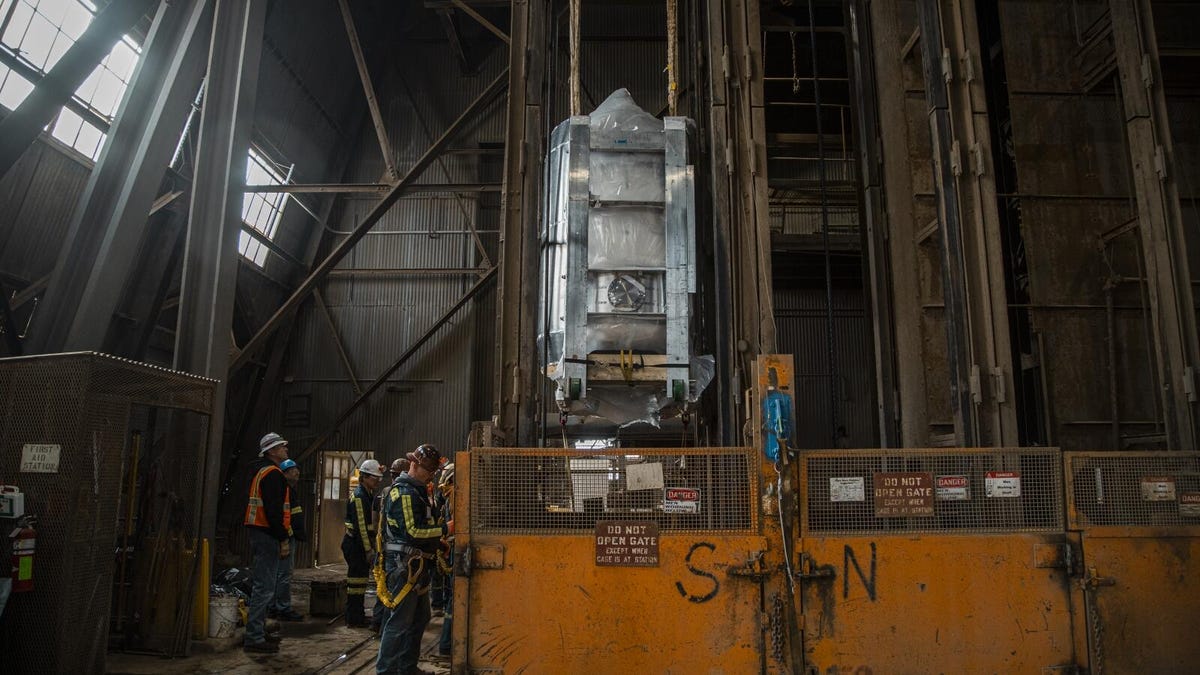Nestled within the landscape of South Dakota lies the deepest subterranean laboratory in the United States, a 1,490 meter below-ground, cutting-edge science cavern called the Sanford Underground Research Facility. The experiments conducted here are just as mysterious as you might expect. Things like neutrino physics, cosmic ray quests, nuclear fusion reactions.
One of them is called — prepare for a mouthful — the LUX-ZEPLIN, or Large Underground Xenon and Zoned Proportional Scintillation In Liquid Noble Gases Experiment. And it relies on a massive, white, cylindrical, awfully sterile-looking device that stands at its heart.
This machine is a dark matter detector.


Pictured here is the Liquid Xenon Time Projection Chamber, the heart of the LZ detector, in the clean room before assembly inside the titanium cryostat.
Matthew Kapust/Sanford Underground Research FacilityAnd on Thursday, the LZ experiment scientists, an international crew composed of 250 experts, announced a pretty big update on the endeavor. The enormous particle hunter has officially been booted up, successfully passed the check-out phase of its startup operations and delivered its first scientific results.
Don’t get too excited, though. These results aren’t our lens into dark matter. Yet. However, they do prove that LZ is definitely working — and so well, in fact, that the team calls it “the world’s most sensitive dark matter detector.”
It’s at least 30 times larger and 100 times more sensitive to finding dark matter signals than its predecessor, the Large Underground Xenon Experiment, or LUX, and it’s deep enough underground to prevent background noise like cosmic rays from interfering with science observations.
“Considering we just turned it on a few months ago and during COVID restrictions, it is impressive we have such significant results already,” Aaron Manalaysay, LZ physics coordinator and member of the Lawrence Berkeley National Lab, said in a statement.
Those results are based on just 60 days’ worth of data, but in the coming years, LZ is poised to capture about 20 times more. “We’re only getting started,” Hugh Lippincorr of the University of California, Santa Barbara, an LZ spokesperson, said in a statement.
What’s dark matter and how will LZ find it?
Dark matter, as its name suggests, doesn’t emit any light. It doesn’t transmit any information. In essence, think of dark matter as transparent. Elusive. Incompatible with human vision.
But despite its evasiveness, we know dark matter is out there. It does seem to interact with the matter we know and see with our own eyes.
The universe is simply expanding far quicker than our physics predicts it should be, and galaxies are strangely held together even though they’re spinning so fast you’d expect all their stars inside to fling out like unhinged horses on a merry-go-round. So, unless we have our physics down incorrectly — or are being tricked into thinking we’re safely anchored in the Milky Way — there has to be an explanation beyond our present equations.
That’s where dark matter comes into play.


Crews at the Sanford Underground Research Laboratory in Lead, South Dakota, lowering the LUX-ZEPLIN central detector deep into the Earth.
Nick HubbardScientists call whatever extra stuff is pushing the universe apart dark energy, and items anchoring galaxies in place are called dark matter. These mysterious phenomena are estimated to make up a whopping 95% of matter in the universe. And LZ is on a mission to find some of it.
In short, the LZ experiment is looking for a specific type of theoretical particle called a “weakly interacting massive particle.” It’s an electromagnetically neutral particle — meaning it’s neither positive like a proton nor negative like an electron — regularly hypothesized to make up most of the universe’s dark matter. It’s also categorized as heavy, which is slightly ironic given its acronym: WIMP.
The plan is basically to see whether it’s possible to catch a WIMP in action, as it interacts with a xenon atom. To do this, the LZ mechanism contains two titanium tanks filled with 10 tons of very pure liquid xenon, Manalaysay explained, which can be penetrated by other particles. With a bit of luck and a lot of precision, the team hopes to catch a few faint interactions between the xenon atoms and those other intruder particles, because one of those particles could possibly be a WIMP. It could possibly be dark matter.
If and when such an interaction does happen, the researchers will see it as a flash of light, followed by a second flash of light as the electrons knocked off the xenon atom — due to the particle collision — drift to the top of the chamber. This is why the LZ device also includes a whole lot of super calibrated light detectors as well as light amplifiers. That light flash is the crux of the experiment.


An incoming particle interacts with a xenon atom, producing a small flash of light and electrons, which are extracted at the top of the detector and produce additional light.
LZ/SLAC“The characteristics of the light signals help determine the types of particles interacting in the xenon, allowing us to separate backgrounds and potential dark matter events,” Luiz de Viveiros, assistant professor of physics at Penn State and LZ team member, said in a statement.
“We want to be ready for physics as soon as the first flash of light appears in the xenon,” Lippincott said in a statement.


